Features of the toilet for the disabled

The bathroom and the plumbing used for people with disabilities must be special, in particular, equipped with handrails and additional elements, have certain dimensions. This allows people with disabilities to independently carry out hygiene procedures, without resorting to the help of other people.
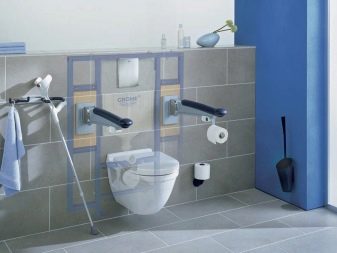
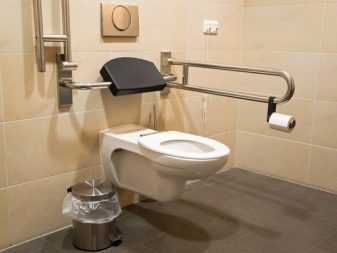
Peculiarities
Special toilets may be required not only for disabled people, but also for the elderly, as well as people leading a sedentary lifestyle due to certain diseases, including patients in the postoperative period.
The main requirement for toilets for these groups of people is the height requirement. Toilet bowls for disabled people are 10-20 cm higher than conventional models. If you can't buy a special (higher) toilet, you can use special overlays that allow you to get the required height of the device. The main thing in determining the height of the toilet is how comfortable it is for the user to change from the chair to the toilet. This takes into account the height of the user, for example, it is difficult for a tall person with problems of the musculoskeletal system to use a toilet bowl of 45 cm.
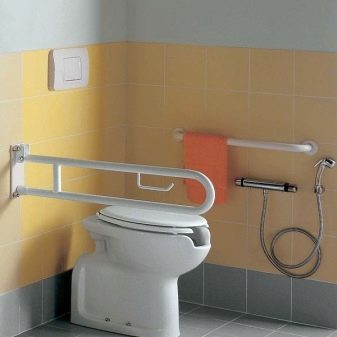
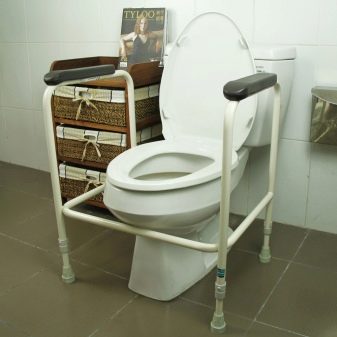
Another important element of special toilets is handrails, support elements, armrests. Their purpose is to help a person transfer from a wheelchair to a toilet. These elements are selected individually for a specific user. Depending on the type of fastening and the characteristics of the application, they can be of several types. More details about the advantages and disadvantages of specific species will be discussed below.
A toilet purchased for a disabled person must comply with GOST, therefore, check with the seller for the appropriate certificates before purchasing.
GOST provides that the minimum distance from the toilet to the opposite wall (and more often the door) should be 60 cm.
There must be at least 25 cm of free space on both sides of the device.


Views
Depending on the type of installation, there are the following types of toilets for the disabled:
- Stationary devices preferable in large bathrooms, where it is possible to install plumbing for healthy people (if they live with a disabled person) and space for placing fixed handrails, strollers;
- Folding handrail device (move up and down and left and right) allows you to achieve ergonomics and ease of use of the toilet;
- Device with removable handrails - the portable version of the handles is attached to the wall with suction cups.
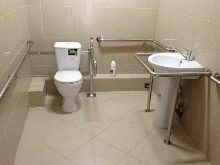
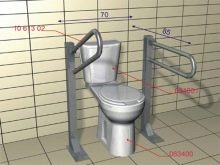

Most wheelchair users are psychologically unprepared to use devices other than a special stationary toilet. Only he seems to them to be reliable and durable, so they are categorically against other models.
Separately, it is necessary to highlight mobile toilets, which are a portable chair or chair with a special compartment for waste products. They are equipped with a comfortable seat, armrests, and sometimes with wheels.
Typically, such devices are used to care for critically ill patients and people with severe musculoskeletal disorders.

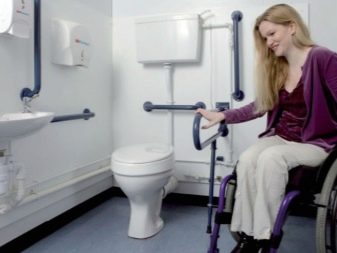
Handrails can be of three types:
- stationary;
- mobile;
- folding.
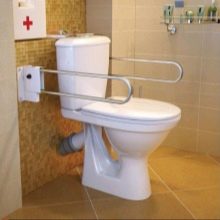
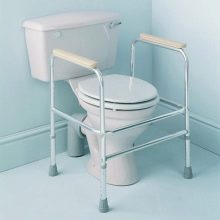

All of them can be fixed to walls or floors. Movable and folding ones are optimal for a small bathroom.
Depending on the size of the bowl, toilets for disabled people can be small (it is better to use them only if it is not possible to buy a children's toilet), compact size (the best option) or large.
Toilet bowls for the elderly and disabled can be equipped with additional options, the most popular of which are the following.
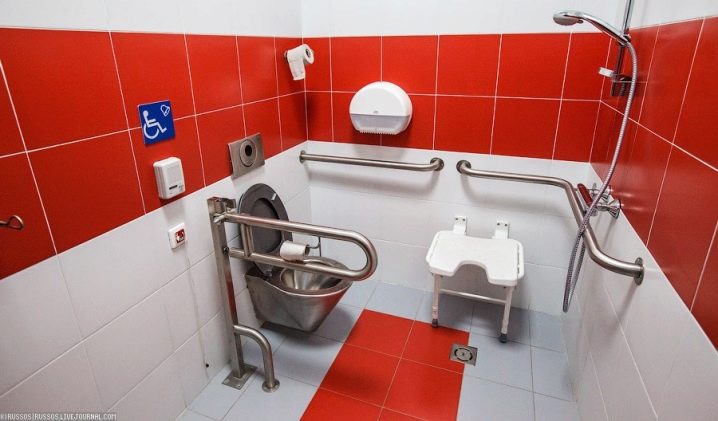
- Hygienic cut-out and armrests attached to the toilet. The latter are equipped with holders for toilet paper.
- Adjustable armrests, the position of which is not linked to each other.
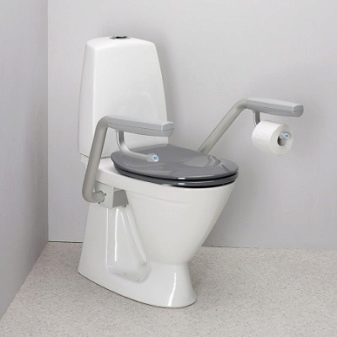

- Toilet covers allow you to adjust the height of the disabled person. This seat has built-in handrails for more comfortable and safe use. They consist of a directly hygienic base of a suitable diameter, metal fasteners and clamps (by changing their position, it is possible to change the height of the nozzle), as well as handrails.
- Automatic lifting lid, heated seat, hygienic shower.
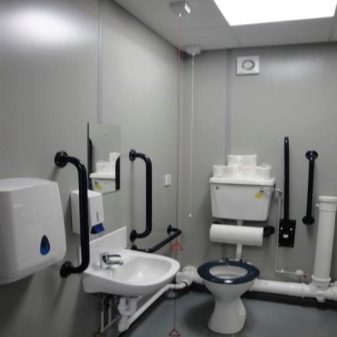

Material
The standard material for the manufacture of toilets for the disabled is faience or porcelain. The first has a more affordable cost, but a shorter service life. Both options are distinguished by their reliability, environmental safety, and ease of maintenance.
If a public space option is being considered, the device must be vandal-proof. For these purposes, stainless steel toilets are optimal. In addition to increased strength properties, they are durable, easy to maintain.
Devices made of natural or artificial stone also have high reliability indicators. In addition, they are durable, easy to clean (dirt practically does not adhere to a perfectly smooth surface), and have an attractive design.
However, it is impossible to find stone toilets for disabled people on sale - they will have to be made to order, which increases the already considerable cost of the device.
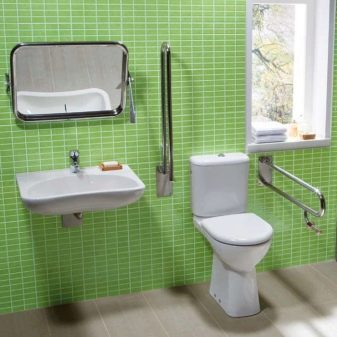
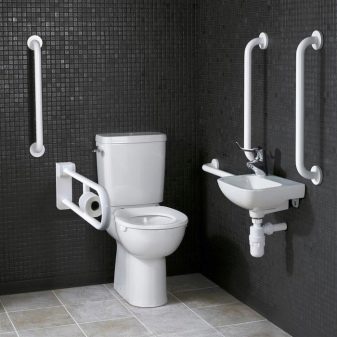
Some manufacturers offer plastic models for people with disabilities. Such devices should be discarded - they are unreliable.
As for the choice of handrails, preference should be given to those made of anodized aluminum or chrome-plated stainless steel. Depending on the design, they are able to withstand a weight of up to 300 kg, are characterized by environmental friendliness, resistance to moisture.
Toilet heads should be made of polymers. They can support the weight of a person, but are light enough. In addition, they lend themselves well to disinfection.
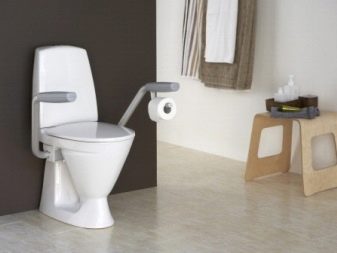
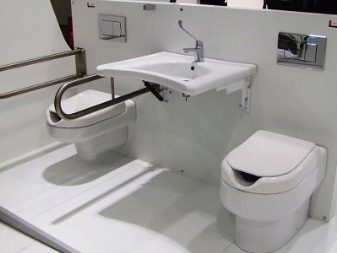
Dimensions (edit)
As already mentioned, the height of toilets for disabled people is 10-20 cm higher than the height of conventional devices. The standard height of the toilet bowl is usually 40-45 cm, for disabled people - 50-60 cm. For wheelchair users, the optimal height of the toilet bowl is 50 cm, corresponding to the height of the stroller.
If it is not possible to purchase a higher toilet, you can use special nozzles. They are removable (that is, installed before each use) and fixed. The first option is suitable for those families who use one toilet, the second - if the person with disabilities has their own (conventional) device.

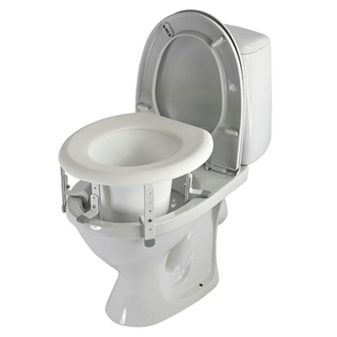
Other parameters (width and length) of the bowl correspond to the usual ones. A standard toilet has a width of 35-38 cm, a length of 48-70 cm. For overweight people, you can pick up large toilets (depending on the size of the bowl, they are divided into small, standard and large). When choosing massive structures, make sure that they fit into the bathroom, while leaving room for handrails and comfortable placement of the stroller in the toilet.

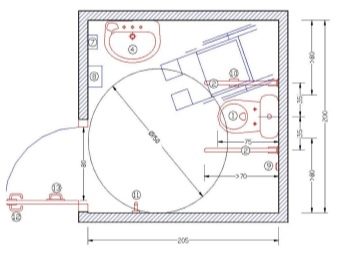
Colors
White is considered a traditional shade of sanitary ware, but today manufacturers offer color models that can be both soft pastel and rich, bright.
When it comes to a visually impaired user, it is recommended to choose colored toilets with bright contrasting handrails. Colored toilet bowls, among other things, can transform the interior, make it more cheerful and brighter. When choosing colored handrails, remember that they should make the disabled person feel secure. That is why it is better to abandon the handrails of a red hue, which is associatively perceived as the color of anxiety. Preference should be given to green, blue, orange shades.

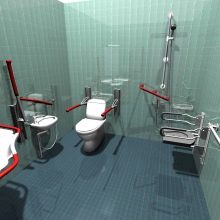

When choosing a toilet with a colored ceramic coating, you should be prepared that it will require more maintenance. Any drops and smudges on it are clearly visible.
Attachments and stands
If it is impossible to purchase a toilet for a disabled person, you can limit yourself to a special mobile cover that is installed on a regular toilet. It has a hygienic circular surface and is height adjustable. Such a device is equipped with handrails and can be easily removed after use. It is recommended to order overlays according to the individual sizes of the user. The advantages of toilet attachments are their versatility and low weight.
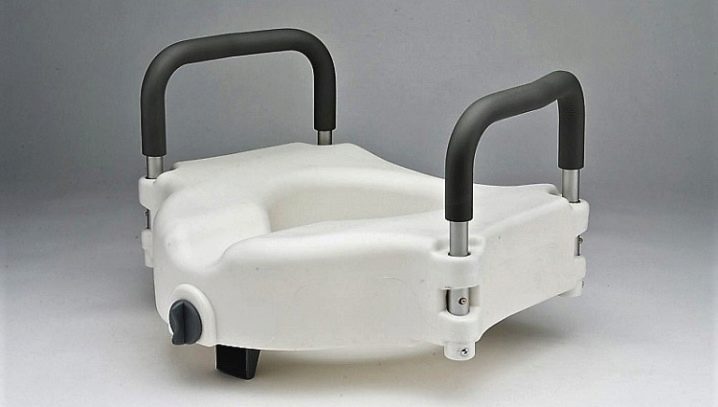
For people suffering from diseases of the hip joints, nozzles of the maximum height (18-20 cm) are recommended. They allow you to reduce the distance between the hip joint and the toilet, relieving stress on the first.
If you have excess weight, you can purchase wider nozzles that allow you to expand the width of the toilet bowl up to 60 cm.
Often, patients leading a predominantly recumbent lifestyle suffer from constipation and hemorrhoids.
In this case, it is better to choose a nozzle that provides the hemorrhoids with the desired position.
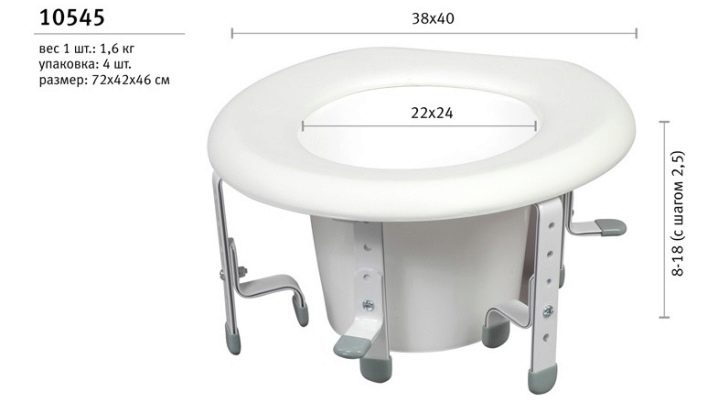
The extensions can have handrails (designed for use by people with severe leg and spine pathologies) or not (suitable for patients in the postoperative period, the elderly and overweight people). The handrails are wrapped in rubber, duroplast or can have fabric inserts, which increases safety and makes them more convenient to use.
Among the useful devices are armrests. They reduce the stress on the arms, allow "unloading" the knees and lower back.
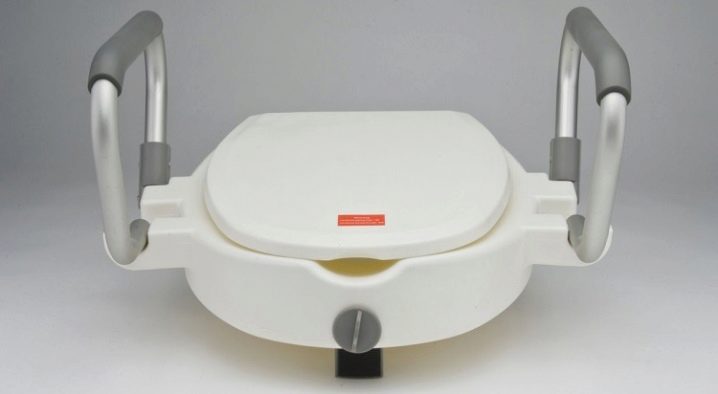
Bidet attachments allow making hygiene procedures more comfortable, as well as reducing the time spent on them.
How to choose?
The choice of a toilet should be based on the user's condition and living conditions. If the bathroom is small, and a disabled person or an elderly person lives with a family, it is wiser to use a standard toilet, equipping it with a special removable nozzle. In a serious condition of the user and the ability to buy and place a special toilet for the disabled, it is better, of course, to do so.

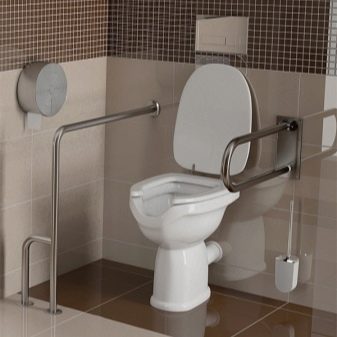
The height of the device must be selected individually and be at least 50 cm from the floor. The most convenient and reliable from a psychological point of view are stationary handrails, however, if there is not enough space for their placement, you can choose any other option.
When choosing an onlay for patients with severely impaired leg and spine function, that is, for those who carry the main load on their hands, pads with handrails should be preferred. For postoperative patients or simply elderly relatives, the toilet seat pads without railings are usually sufficient.
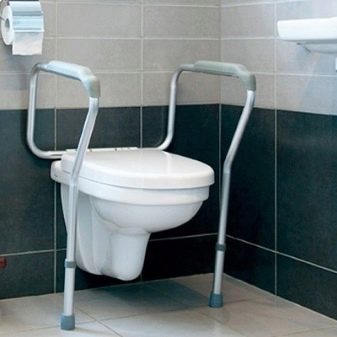
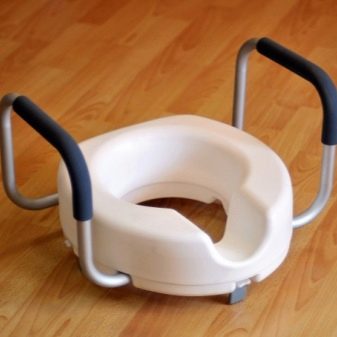
Manufacturers and reviews
The most budget models of toilets for the disabled are produced in China and Taiwan, but German and American devices are more reliable and durable.
Devices for the disabled in Finnish receive positive reviews brand Ido... They are distinguished by their durability (achieved through the use of porcelain and high-quality fasteners), simple and reliable installation, a wide range of options for placing handrails, adjustable armrests, as well as the presence of a special coating that ensures ease of care of the product.
There is only one drawback - a rather high price.
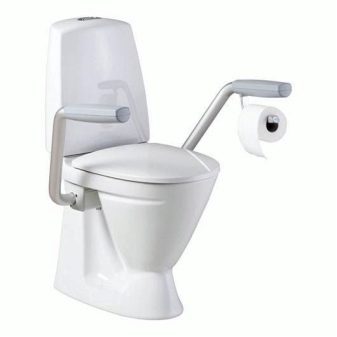
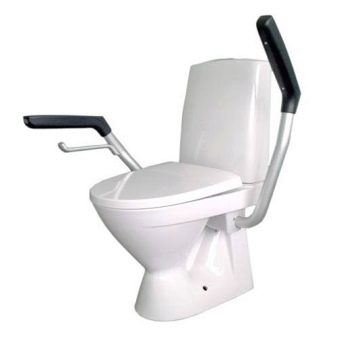
Reliability and functionality are demonstrated by products from a German manufacturer Villeroy Boch... The most popular are floor and hanging models with support handles, a seat with a microlift system, and a built-in bidet. The manufacturer gives a 5-year warranty for toilets, provided that the installation is carried out by representatives of an official service center.
Toilet bowls demonstrate high quality and affordability "A person" from a domestic manufacturer. Most of the models are tall floor devices, handrails and other elements can be purchased separately from the same manufacturer. However, in the catalogs there are many models with stationary and folding handrails.
According to user reviews, it is better to purchase devices with a microlift system, a built-in hygienic shower or bidet. Of course, such toilets are more expensive, but the higher price is justified by the comfort that their use gives.
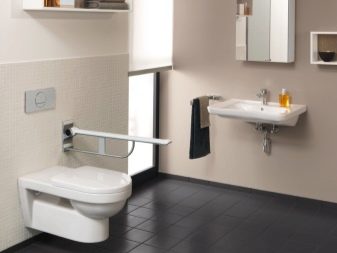

Tips & Tricks
Before purchasing a toilet for a disabled person, you should carefully measure the toilet room and make sure that the selected model will take a comfortable position in it, and there is enough space for all the fixtures.
When purchasing a device, it is important to make sure that all components are in stock.
Use optional accessories such as anti-slip polyurethane handrail pads.


Each type of handrail has the maximum load for which it is designed. Please read these parameters before purchasing. When buying handrails for people with arthritis, go for curved handrails. When using them, the load from the hands is transferred to the forearms.
At first glance, ribbed handrails are more comfortable. However, do not forget that most elderly people have a high sensitivity of the skin, so the grooved pattern of the handrails can cause them discomfort.
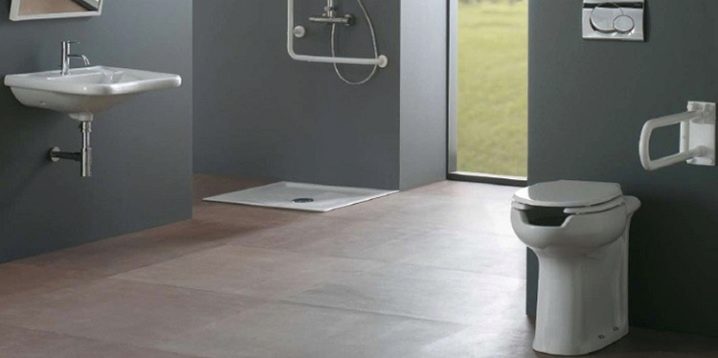
You can find out how to install armrests on a toilet for disabled people from the video below.













The comment was sent successfully.